Abstract
Demographic processes play an important role in economic growth. They form the qualitative and quantitative composition of the human capital. Therefore, the study of the working age mortality issues becomes relevant. The scientific novelty of this research proposes an informational and methodological approach to the study of the working age mortality processes. This approach includes the identification of the working age mortality trends in the years 2005-2018. We specified a shift in the pattern of the working age mortality caused by major disease classes over the observed period of the downward mortality trend. We used the method of structure/dynamics analysis to reveal a significant impact of two classes of the death cause on the mortality change in the reference period. These classes are: system of blood circulation diseases and external factors. However, the index of structural differences indicate little or no difference in the cause of death structure in the observed period of time. Regional differentiation by the working age population fatality rate carried out by the method of typological grouping allowed to identify specific groups of regions. The formation of labor capital in conditions of limited population replacement requires significant demographic situation improvement. On the other side, some serious efforts have to be made to reduce the employment age death rate. The informational and analytical approach to the study of the mortality is useful for a design of contemporary demographic policy, effective managerial decisions on various levels to ensure progressive demographic development.
Keywords: Classes of death causemortalitystructural-dynamic analysisworking age
Introduction
Issues of increasing demographic burden on people of working age were addressed in the work of Ismerov et al. (2014). The study of differentiation of men and women lifespan as well as the subject of retirement age in various countries was carried out by Aganbegyan (2015). Also, of great importance is the study of gender differentiation in population mortality indicators and mortality cause issues implemented by a number of authors: Rochelle et al. (2015) and Sundberg et al. (2018). The study of mortality dynamics in single regions was carried out by Timonin et al. (2017). Studies on the effects of tobacco smoking on mortality among the US adults were conducted by scientists: Lariscy et al. (2018). Researchers: Kossova et al. (2020) address the issues of mortality rates and socio-economic indicators that identify causes of death associated with smoking and alcohol abuse. Authors: Lyytikäinen and Kemppainen (2016) investigate differences and the role of socio-demographic factors in self-reported health in Russia.
Problem Statement
The deterioration of health resulting in the spread of dangerous diseases and the reduction of healthy life expectancy, hampers the continuous and sustainable socio-economic development. A vital socio-demographic problem, along with low fertility, is the combination of processes associated with the mortality in certain population groups, in particular the one of the working age. The informational and analytical approach we employ contributes to the timeliness of this research. Our study incorporates the evaluation and estimate of mortality trends, a structural and dynamic assessment of the able-bodied category mortality by the classes of mortality cause, and reveals regional differentiation by the level of this indicator. The method of typological grouping and content analysis was used to distinguish four groups of regions. These are groups with low, medium, high and extremely high mortality rates in the labor force age. Thus, the proposed approach provides results that can serve as a basis for developing a mechanism for effective management decision-making to reduce the mortality rate of the Russian population and hinder inequality of federation entities in terms of working age population morbidity.
Research Questions
To keep the population stable, an effective demographic policy should affect an important demographic process, such as mortality. The high morbidity rate of the able-bodied category is associated with social/demographic and economic losses. These costs significantly affect the labor potential, production, age structure and standard of living of the population. As an employment age population downsize, a lack of workforce resources becomes almost imminent. Today the Russian demography experiences a recess: as the generation of 1960s, when the birth rate was at its high in the USSR, meet its retirement age, a small generation group of those borne at the turn of the century, called "the millennials" are just entering the employment age. A strong outflow and a small inflow of workforce in the labor market inevitably leads to a growing demographic burden on a working age population on the part of a senior citizens group. The need to address this critical issue as well as many other goals is highlighted in the National Health Project. Another vital issue is a vital need to reduce the morbidity rate of the employment age. It is planned to achieve an indicator of less then 350 cases per 100 thousand people by 2024, compared to 482.2 per 100 thousand people in 2018.
Purpose of the Study
The aim of this statistical research is an in-depth analysis of: the size, composition and dynamics of the employment age mortality in Russia. In compliance with the purpose of our research we outlined the following directions in our study to solve specific tasks:
- identification of trends in mortality of the labor-force age;
- specify changes in the morbidity patterns in the employment age in terms of primary death causes;
- give an assessment of local differentiation by the population morbidity rate with the allocation of four characteristic groups: with a low mortality rate of working age, with an average level, high and extremely high. The research object in our work is the Russian population of the employment age. The research subject - is the population mortality as a mass statistical process, covering the entire set of single deaths in the population of working-age in a particular territory over a certain period of time. Information support includes: the Russian Ministry of Health-care, open data published in periodicals and global Internet.
Research Methods
In this research the analysis of the labor force age mortality rely on generally-accepted scientific research methods of dialectics and comparisons. The statistical tools are: the graphical, tabular and ranking methods. We employed statistical methods of analysis as well. The time series analysis was used to detect working age mortality trends. We applied the structural-dynamic analysis method and the integral coefficient of structural differences to detect the change in the content structure of the labor age morbidity in 2005- 2018 by the main classes of death causes. The method of statistical typological grouping made it possible to highlight characteristic qualitatively homogeneous groups. To conduct an assessment of the regional differentiation by the mortality rate, the ranking method was used.
Findings
Despite the downward trend in recent years the problem of high employment age mortality of population in the Russian Federation remains acute. Based on available data to estimate working age morbidity, we carried out the time-series analysis (Table
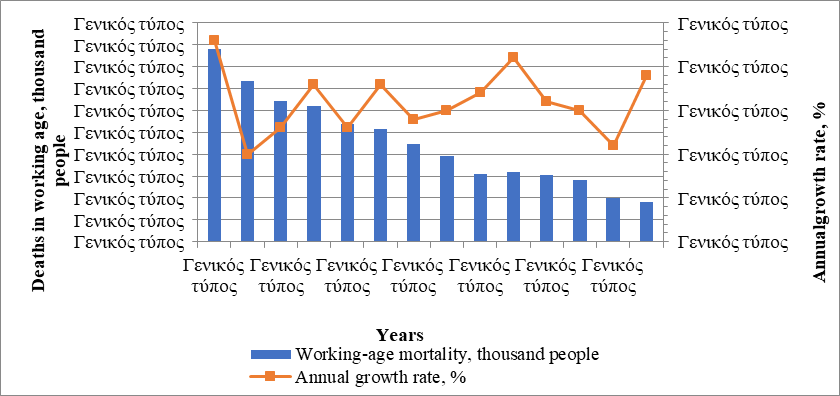
Source: authors.
Simultaneously, aside from a drop in a death count, there have been changes in mortality composition, specifically in the main classes of death causes. One of the most prominent characteristics of morbidity is the allocation of the number of death instances by a death cause. It allows to forecast the main trend for further reducing mortality. Over time, the structure of mortality allocated by death causes changes and there are many reasons for that. Evolution in medicine, national healthcare programs, changes in quality of life, gender and age composition in society - all this influence the structure of mortality. Table
In 2005, the largest proportion of deaths per 10,000 people was recorded as a result of external causes, namely: alcohol poisoning, transport accidents, homicides and suicides - 32.5 %; and from blood circulation system diseases- 32.0%.The share of several disease classes as a cause of death in the total death count was much less: infectious and parasitic diseases (4.2%), digestive diseases (6.9%) and respiratory diseases (5.4%). As in 2005, the year 2018 marked high labor force age mortality in population due to death from blood circulation system diseasesand amounted to 30.4%, as well as fromexternal factors- 24.3%.There is a decrease in mortality due to respiratory diseases (3.8%). The results are shown in Figure
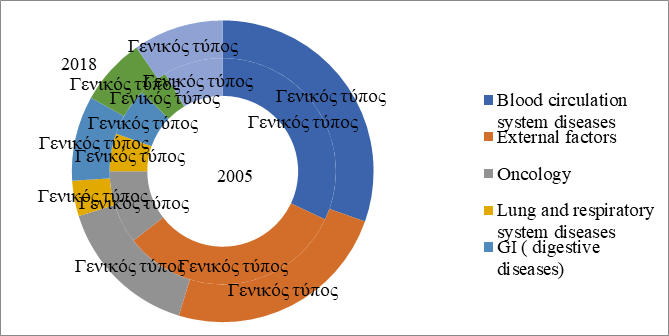
Source: authors.
A substantial growth of the labor force mortality during the analyzed period occured from tumors and amounted to 5.0 p.p. or 47.6% compared to 2005. It's noteworthy that mortality associated with infections and parasites diseases has also increased (by 71.4%). The diseases of digestion gave an increase (by 31.9%) as well. At the same time, two classes of death causes saw a significant mortality reduction, these are deaths associated with lung and respiratory system diseases (by 29.6%), other external factors (by 25.2%) and a small reduction in morbidity from blood circulation system diseases(by 5.0%). To determine changes in the composition of population, the Ryabtsev index (Ryabtsev & Chudilin, 2001) is applied ( ):
The value of this index was 0.115 (11.5%) for the period 2005-2018, it's value indicates a very low level of structural differences. The overall view at the mortality composition in Russia confirms that the so-called "vital behavior" of the population has a decisive effect on the overall mortality rate: a high level of human self-preservation activity, living a healthy lifestyle and abandoning bad habits.
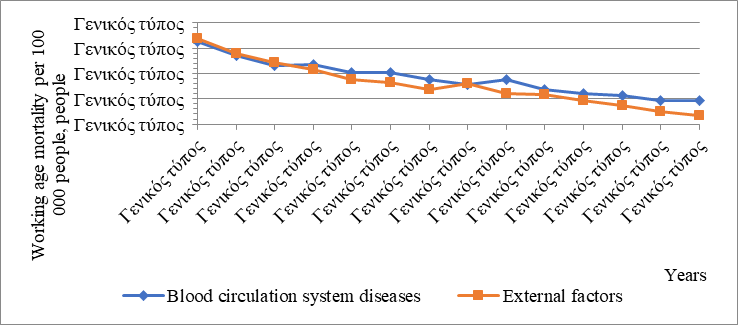
Source: authors.
In fact, circulatory diseases and external causes of death comprise over 50% of all losses of life in Russia today. So, it is worthwhile to consider these causes of death separately (Figure
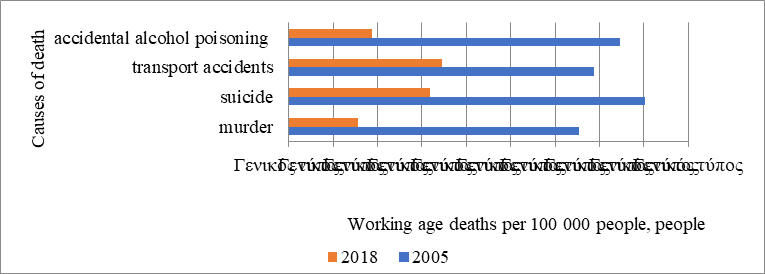
Source: authors.
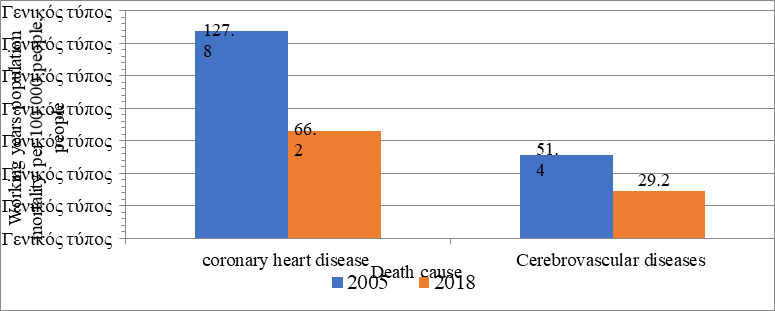
Source: authors.
In 2005, in a cluster of external death causes, suicide mortality took the leading position with 40 deaths per 100 thousand in labor-force age. By the end of the period, this indicator has fallen by 60.4% down to 16 incidents. Homicide mortality in employment age went down 76.1% down to 8 deaths per 100 thousand. Because of the problem of poor-quality and counterfeit products, together with high alcoholization, in 2005 for every 100 thousand people 37 died from alcohol poisoning. According to data for 2018, mortality decreased by 74.8%, down to 9 cases per 100 thousand people. Mortality from traffic accidents has also decreased in these years, but not so much (by 50%) and still remains an urgent problem, the solution to which could lead to even more decrease in labor-force age mortality. Figure
Cerebrovascular diseases provide some of the highest rates of mortality and disability. They are characterized as being the biggest problem in modern neurology. During the period 2005-2018 mortality from cerebrovascular diseases decreased by 43.2%, down to 29 deaths per 100 thousand people in 2018.While analyzing the development of the demographic process of mortality in working age, it is important to take into account territorial features of Russia. In this instance, the typological grouping method was used to reflect the degree of regional differentiation by the employment age mortality rate. In our study we separated regions in four groups: the ones with a low working age mortality rate, with an average level, high mortality rate and extremely high, based on a content analysis of the indicator values (Table
Beginning January 2019, the national project "Health Care" has started in Russia (Ministry of Health of the Russian Federation, 2019). This project is focused on a set of measures ensuring a reduction of labor force age mortality down to 350 instances per 100 thousand people by the year 2024. Note, that in the group with a low mortality rate in working age, mortality does not exceed the target. At present to ensure a reduction in mortality in the rest 78 regions of Russia a complex solution to a set of problems is to be found.
Conclusion
The study of mortality in working age in Russia for 2005-2018 was carried out using methods of analyzing the time series and generalizing indicators: absolute, relative and mean value. It was determined that on average the annual reduction of mortality amounted to 26.7 thousand, or 4.7%. In 2018, the reduction slowed down and amounted to 6.3 thousand people die, or 1.6%. A structural/trend analysis of working age people mortality showed that a decrease was generally observed due to external factors and bloodcirculation system diseases. The total reduction was 41.7%, including 18.5% and 14.1% for these classes, respectively. The decrease from external causes was bigger then the one from diseases of the circulatory system. The Ryabtsev index (integral coefficient) let us to give a comprehensive assessment of changes in the structure of mortality causes as having a low level of differences. A detailed study of mortality from these two classes of death causes has indicated that most deaths from external causes come from transport accidents and suicides (17 and 16 incidents per 100 thousand people respectively).The human capital in Russia is formed in conditions of limited reproduction. Compared to European countries, the labor potential of Russia shows a low level for health reasons. Labor-force age mortality of the population is high. Annual economic losses associated with mortality of the able-bodied category of population account for about 2% of gross domestic product (GDP). Mortality for the first 3 months of 2020 exceeded the figure for the same period of 2019. Demographic situation improvement, working age mortality reduction, and human capital enhancement appear to be a difficult task for a long-term period. The potential capacity for the reduction of the employment age mortality can be possibly found in the area of the circulatory system disease prevention, and transportation system enhancement to reduce road traffic accidents. To reduce mortality, it is necessary to develop effective measures and make effective managerial decisions at various levels that ensure positive progress of demographic development of Russia and its regions. This complex task requires working out, adoption and implementation of an effective policy as well as a significant financial investment.
Of all the deadly outcomes from diseases associated with the circulatory system the most problematic ones include: mortality from coronary heart disease (66) and from cerebrovascular diseases, 29 instances per 100 thousand people. The regional insight of the problem allows us a more thorough understanding of the labor force age mortality problem. In this research we implemented the ranking method, typological grouping and content analysis of indicators to take a closer look at the problem of mortality. As a result, 4 groups of Russian regions were singled out: the ones with a low, medium, high and extremely high working age mortality rate. Thus, all 85 entities fit nicely in these four groups. The extent of differentiation of the mortality indicator values in two extreme groups including just 20% of regions was estimated to be at 180%, which indicates a significant degree of differentiation of the mortality rate. In further studies, perhaps, more of attention should go to the analysis of low life expectancy in the Russian Federation and focus be made at the citizens' standard of health.
National demographic security requires measures to slow down natural population decline and an effective policy to provide population natural growth rate in the future. The nation's health serves as the main resource for the sustainable development of the country. To provide an effective population maintenance, mortality, a key demographic problem, should be affected. Implementation of the national Health Care project is focused at sustaining life and health of workers engaged in labor market activities. It has an effect on demographic problem solution and also on a development of a competitive Russian economy. It is essential to improve the provision of primary medical care and early diagnosis especially for cardiovascular and oncology diseases, to enhance training of medical specialists, and to foster the development of national medical centers. An array of long-standing social problems must also be addressed by way of: improving the quality of life, combating alcoholism and tobacco smoking, improving working conditions throughout the regions of the Russian Federation.
References
- Aganbegyan, A. (2015). Increasing the extremely low Russian population life time — The most important immediate task. Economic Strategies, 5-6, 60-79.
- Ismerov, N. F., Tikhonova, G. I., & Gorchakova, T. Yu. (2014). Mortality of the working age population in Russia and developed countries of Europe: Trends of the last twenty years. Bulletin of the RAMS, 7-8, 121-126.
- Kossova, T. V., Kossova, E. V. & Sheluntcova, M. (2020). Gender gap in life expectancy in Russia: The role of alcohol consumption. Social Policy and Society, 19(1), 37-53.
- Lariscy, J. T, Hummer, R. A., & Rogers, R. G. (2018). Cigarette smoking and all-cause and cause-specific adult mortality in the United States. Demography, 55(5), 1855-1885.
- Lyytikäinen, L., & Kemppainen, T. (2016). Regional inequalities in self-rated health in Russia: What is the role of social and economic capital? Social Science and Medicine, 161, 92-99.
- Ministry of Health of the Russian Federation (2019). National Project "Health Care" 2019. https://minzdrav.gov.ru/poleznye-resursy/natsproektzdravoohranenie
- Rochelle, T. L., Yeung, D. K., Bond, M. H., & Li, L. M. W. (2015). Predictors of the gender gap in life expectancy across 54 nations. Psychology, Health & Medicine, 20(2), 129-138.
- Ryabtsev, V. M., & Chudilin, G. I. (Eds.) (2001). Regional statistics. Moscow Publishing House.
- Sundberg, L., Agahi, N., Fritzell, J., & Fors, S. (2018).Why is the gender gap in life expectancy decreasing? The impact of age- and cause-specific mortality in Sweden 1997-2014. International Journal of Public Health, 63, 673-681.
- Timonin, S., Danilova, I., Andreev, E., & Shkolnikov, V. (2017). Recent mortality reversal in Russia. Are all regions following the same tempo? European Journal of Population, 33(5), 733-763.
Copyright information

This work is licensed under a Creative Commons Attribution-NonCommercial-NoDerivatives 4.0 International License.
About this article
Publication Date
30 April 2021
Article Doi
eBook ISBN
978-1-80296-105-8
Publisher
European Publisher
Volume
106
Print ISBN (optional)
-
Edition Number
1st Edition
Pages
1-1875
Subjects
Socio-economic development, digital economy, management, public administration
Cite this article as:
Chistik, O. F., & Kosyakova, I. V. (2021). Analyzing Processes Of Workingage Mortality: Regional Approach. In S. I. Ashmarina, V. V. Mantulenko, M. I. Inozemtsev, & E. L. Sidorenko (Eds.), Global Challenges and Prospects of The Modern Economic Development, vol 106. European Proceedings of Social and Behavioural Sciences (pp. 1344-1353). European Publisher. https://doi.org/10.15405/epsbs.2021.04.02.160

